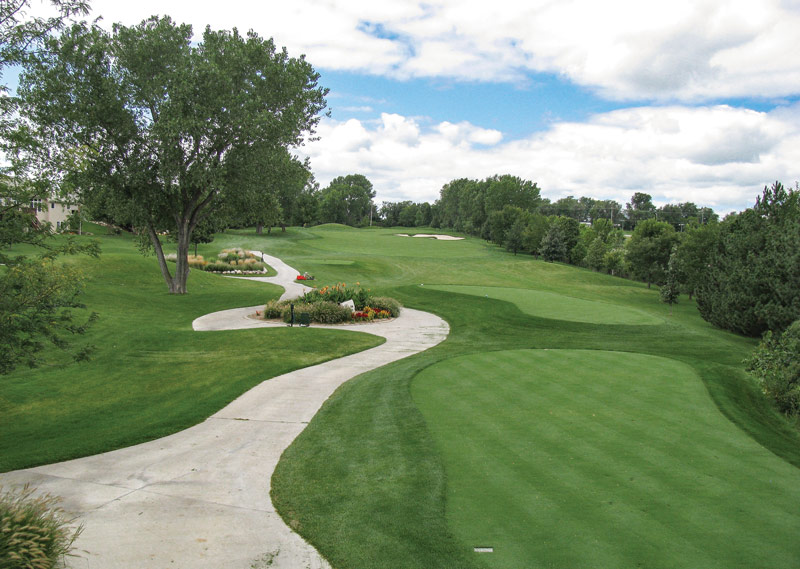
Tees are the game’s gateways, so keeping them healthy and enticing is key in providing a quality, memorable golf experience. Photos courtesy of John Fech
Second only to the clubhouse in terms of visual and visceral impact on the golfer, the tee box sets the tone for a positive or negative experience during a round of golf. Think of it — the tee box is where the driver is put to use, the lessons pay off and the chance to be in contention for par takes place.
Creating and maintaining an attractive and well-functioning space is a critical consideration in these locations. Shade, wear, moss, surface roots, debris, non-plant elements and airflow challenge the success of a tee box, while well-placed perennials and woody plants can enhance it.
Throwing shade
Overwhelmingly, the most common problem voiced by participants in a GCSAA seminar that superintendent Dan Maddox and I taught recently was that shade from trees is a strong negative influence on the performance of turf on tees and greens. It’s funny, in a way, that as humans, most of us like the shade — that’s where we tend to hang out on a hot, sunny summer day. Dermatologists warn us against overexposure to direct sunlight, which can lead to skin cancer. But turf plants are not humans, and we must think differently about what is required for their optimal health.
The first consideration in this endeavor is the “volume” of shade. There is no question there are varying degrees of shade — full, dappled, light, morning/afternoon, produced by differing levels of canopy density of various tree species. As you consider the amount of light the tee surface receives, it may be helpful to think of a lack of sunlight as “shade stress,” as this may make it easier to relate to — more like injuries from insects, diseases or weather-related agents, which tend to be more visual.
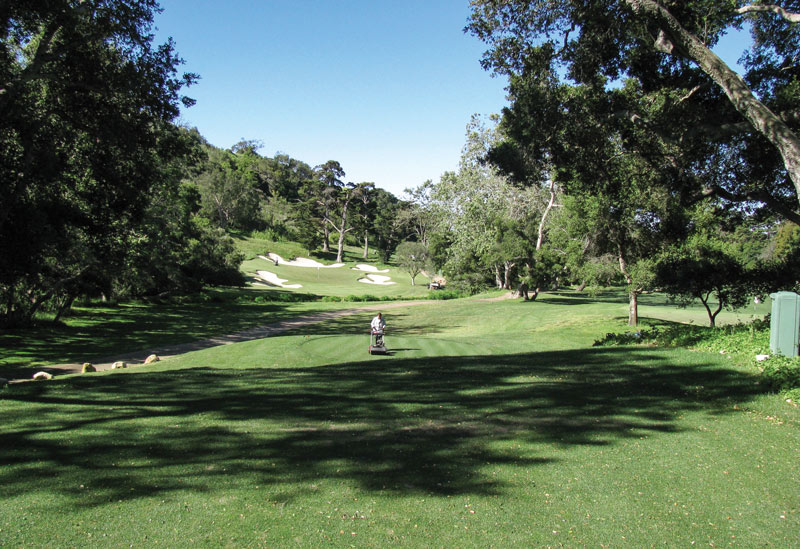
Shade reduces light quality, creating stress that in turn causes thinner turf, more pests (insects, diseases and weeds), and more upright growth but slower growth overall.
Shade stress can be broken down into six major categories of influence:
-
Quality and quantity. Most notably, the moles (units) of intensity and number of hours of total sunlight.
- Time of day. For example, an hour in the morning might only produce 2 moles, as opposed to an hour in the early afternoon, which may produce 6 moles.
- Location and direction. This is determined largely by the proximity of the cause of the shade to the turf surface and whether it is affecting locations to the south rather than to the east and west.
- Species of tree and canopy characteristics. When considering these, the leaf shape and number are important.
- Age, size and shape of tree. For example, is the tree shaped like a vase or a lollipop, or does it mimic a fruit tree?
- Shade tolerance and sunlight requirements of turf species in place. Creeping bentgrass will have different tolerances and needs than bermudagrass, which will be different from those of tall fescue, and so on.
Editor’s note: In the delicate discussions of shade and trees on the golf course, data can be a superintendent’s strongest ally. So, how much light is enough light, and how can you best measure it? See Measuring light for healthier turf.
Shade on tees: Truth and consequences
In general, at least five consequences result from less-than-adequate light levels. First, as David Gardner, Ph.D., a professor at Ohio State University, reports, the ratio of red to far-red light is reduced, which results in the reduction of root growth as the energy in the turf plants is shifted into leaf production. In short, reduced light quantity results in a reduction in light quality, which is a bigger issue than the loss of quantity.
Roch Gaussoin, Ph.D., and Bill Kreuser, Ph.D., at the University of Nebraska-Lincoln indicate that light-quality reduction also leads to thinner cell walls and greater elongation in a more humid environment, all of which spells trouble for the turfgrass plants. Putting numbers into the mix to help illustrate this phenomenon, they report that a healthy red to far-red ratio is 1.5 to 1, while a shade-stressed site would commonly have a threefold reduction of 0.5 to 1.
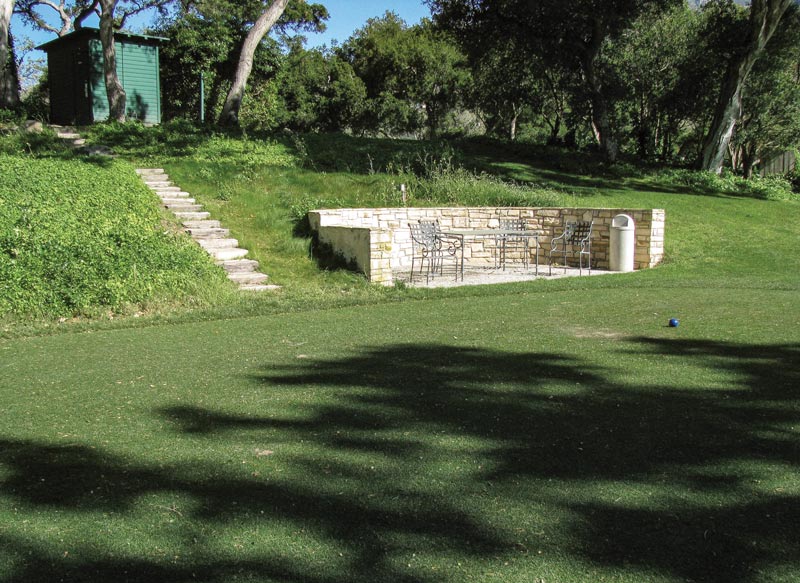
The type of shade (for example, dappled or full) affects the quality and quantity of light the turf receives.
Numbers aside, what does that mean for the turf plants on a tee box? In terms of observable outcomes, shade stress results in thinner turf, increased pest incidents, more weeds and moss, more upright growth, reduced lateral growth, and an overall slower growth rate. Additionally, trees usually get bigger over time and will thus produce more shade, magnifying the stress.
With all of these negatives in mind, should all the trees around a tee be cut down and chipped up? It’s not that simple. The value that trees bring to a golf course demands that certain trees remain and new ones be planted. Solutions in the context of future management can be implemented that will reduce the impacts of shade stress:
-
Like other kinds of stress, shade stress must be monitored. This should be done visually and with instruments such as a daily integral meter.
- Implement a low-nitrogen program, generally in the range of 1 to 2 pounds of nitrogen per 1,000 square feet per year, as traditional fertilization rates will cause further, excessive elongation.
- Implement a well-balanced, well-monitored plant growth regulator program based on recommendations made by nearby land-grant university researchers.
- Scout and monitor for pathogenic diseases, especially rust, powdery mildew, leaf spots, brown patch and pink snow mold.
- Change, modify or remove trees and shrubs near the shaded site. The crucial decisions are which ones should go, which should stay, and where they should be. Consider future growth rates and canopy effects.
Editor’s note: Read much more about trees in the golfscape — proper maintenance, removal, pest prevention and more — from author John Fech.
Additional tee box maintenance challenges
Shade is not the only challenge related to ornamentals on tees by a far sight. At least five others should be examined.
Reduced airflow
In addition to shade, trees and shrubs impart a certain influence of modified airflow over a tee. Again, this influence is dependent on the physical makeup of the actual plant material, with density, height, shape and number of specimens making a variable blockage pattern. Consider the example of palm trees versus an arrowwood viburnum hedge. A much greater amount of air can pass through the canopy of the former than the latter. In fact, if you want a good privacy hedge for screening off an undesirable vista on one side of a fairway, arrowwood, chokecherry, plum, arborvitate and cotoneaster are good choices.
Wear
Landscape/golfscape design can have a big influence on wear patterns on a tee. This is largely a consideration of placement of the ornamental plants. The solution may be as simple as identifying pinch points — the plan is to eliminate, modify or widen closely spaced specimens to spread out wear damage and better direct traffic flow. Another possibility is to create multiple setups to bolster dispersal of golfers. One way or another, each tee area should have sufficient access.
High-maintenance plantings
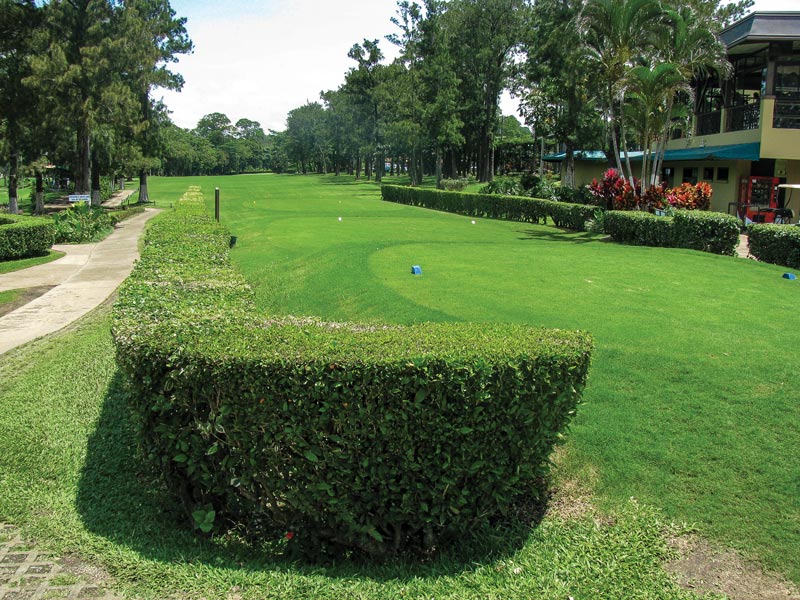
Hedges are high-maintenance plantings and should be reserved for the clubhouse area.
In general, annuals, containers and hedges fall into the category of high-maintenance plant material. This group needs frequent watering, higher-than-average fertilization and repeated pinching/grooming/pruning. Though they don’t require daily watering, hedges are certainly maintenance hogs, especially if the goal is a formal appearance. Limiting high-maintenance plantings to the clubhouse and signature holes will reduce tee box troubles.
Stability of nearby trees
In addition to the shade cast by trees, their overall condition is important as well. Cracks, hangers, decay and co-dominant leaders are examples of defects that can cause troubles for golfers as well as the superintendent, especially in today’s litigious society. The best plan to avoid troubles is to consult with an ISA (International Society of Arborists)-certified arborist to identify and mitigate potential hazards.
Non-plant elements
Ball washers, tee markers, benches and water coolers can create extra work (hand trimming and maintenance). When these elements are located improperly, string trimming is required to keep them functional and aesthetically pleasing. When they can be designed into another element that requires minimal maintenance, such as a mulch or rock bed, the time for trimming gets reduced.
Making tee box enhancements
Improving the aesthetic appeal of tee boxes is an obvious goal, but your ability to achieve that often depends on one main factor: location.
The real estate battle cry of the 1970s — location, location, location — helps convey the importance of location. For readers younger than, say, 40, from 1970 to 1979, you could sell a really crummy house for top dollar as long as it was located near an ocean, a popular recreational feature or maybe someone’s workplace. It seems like house buyers have smartened up since then, probably because they ended up being stuck with a money pit that happened to have a nice view.
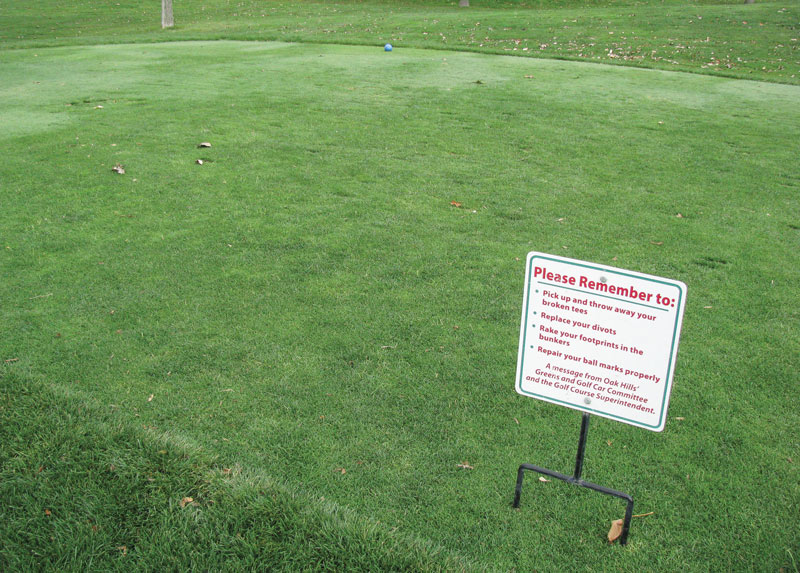
Because tees are an area where players congregate, they are an ideal spot for signage that offers gentle reminders on matters such as divot replacement, ball mark repair and bunker raking.
As that relates to improving your tee boxes, if colorful flower beds are to be used, the best place for them is on the opposite side of the approach to the tee rather than in the space between the cart path and the tee box. In this way, a golfer can admire the plants while striding to place the ball on the turf, yet not have to squeeze by them and create additional wear on the turf.
Similarly, the main strategy is to plant some ornamentals around the tee and some in close proximity to the tee so that they can be seen and enjoyed but won’t cause problems on the tee. In some cases, there is little need for planting and caring for ornamentals at all if there is a “borrowed view,” such as a nearby property with a desirable feature that can be seen from the tee box.
Even though vistas and color are important to golfers, that doesn’t mean they need to be added in a way that requires a lot of work from the superintendent. The goal of their use is to create high-quality aesthetics, not problems. A simple but effective way to accomplish this is to plant colorful or
evergreen shrubs near or under existing trees to bolster the understory. A planting of this type rarely creates increased maintenance for the superintendent or golf course workers, yet it provides a close-up view of color, texture and spatial enhancement for the golfer, one that replicates Mother Nature in the process.
‘Can’t-miss’ options
Some tee box troubles can be prevented by hitting the easy button. It’s important to use tried-and-true plant material, matching choices to the site conditions. Using the phrase “right plant, right place” as a guiding theme, start by replacing poorly sited plants with those from your “can’t-miss” list. If you don’t have such a list, make one with the help of a local arboretum, botanical garden or Extension horticulturist. Use this as a foundation for plantings. After plantings have been installed, experiment with the latest and greatest new releases to increase the chance of success.
For example, consider the following on shady sites:
-
Trees: redbud, serviceberry, hornbeam, witch hazel, pagoda dogwood
- Shrubs: coralberry, snowberry, blue holly, boxwood, bottlebrush buckeye, alpine currant
- Perennials: hostas, bleeding heart, Japanese anemone, ligularia, bugloss, Solomon’s seal
- Ground covers: Japanese spurge, Bishop’s goutweed, spotted deadnettle (lamium), lily of the valley, lady’s mantle, periwinkle
Balance these by avoiding the ever-present and overused, as well. Some plants, such as barberry, agapanthus, petunia, zinnia and daylily, may qualify. The idea is to incorporate underutilized, well-adapted, low-maintenance plants that provide high aesthetic appeal.

Stationing ball washers, tee markers, benches and water coolers in areas with hardscapes, rock beds or mulch can eliminate extra maintenance. Ornamentals should be placed around the tee or close by so they can be enjoyed by golfers but won’t interfere with play.
Defining the space around tee boxes can also be helpful. Wide-open spaces might be in the master plan, or there may be a desire to define the tee and set it apart from the fairway. Actually, space definition is one of the hallmarks of golfscape/landscape design; however, it must be accomplished with shade, wear, airflow, maintenance inputs, plant condition and plant material selection in mind.
When defining the tee box space, mixed, well-spaced trees behind the tee, multi-stem shrubs on the opposite side of the approach, flowers in front of the shrubs, a multicomponent planting on the left side of the fairway, and an occasional container or two for a pop of color are great specific arrangements to plan for. Any part of the various elements can be repeated or deleted depending on the themes of the course.
Finally, because tee boxes are a place where every golfer in a grouping will gather at the beginning of a round, they can be a great location to communicate best management practices and golf etiquette. If it fits with the local vibe and feelings of the green committee, consider simple signage to convey messaging regarding repairing divots, staying on the cart path, etc.
John C. Fech is a horticulturist and Extension educator with the University of Nebraska-Lincoln. He is a frequent and award-winning contributor to GCM.